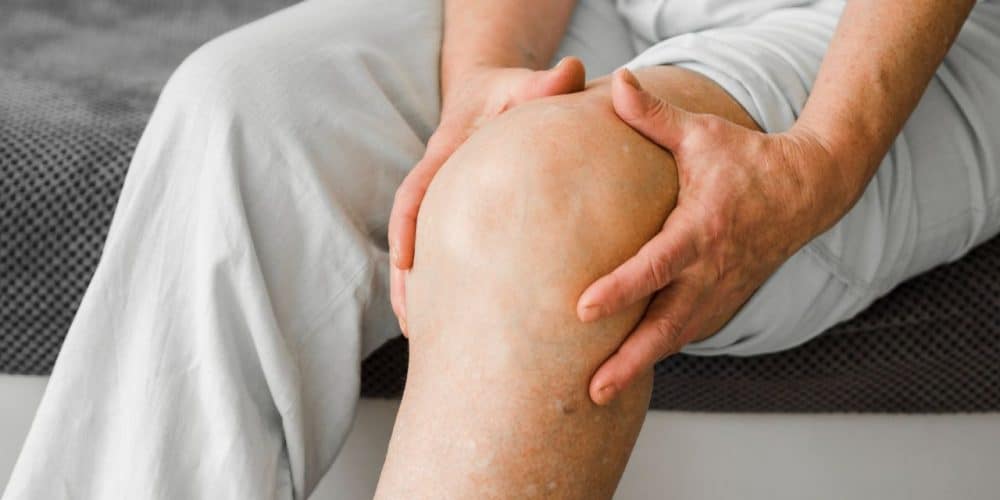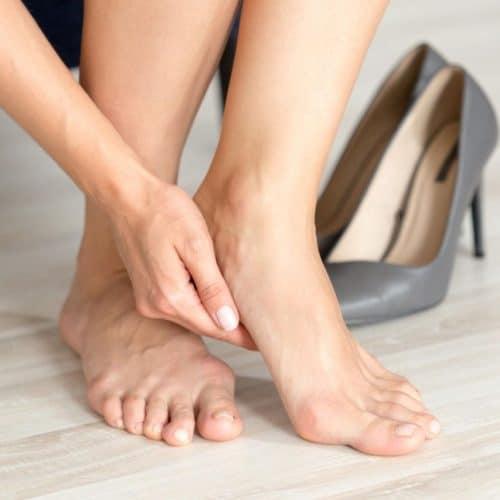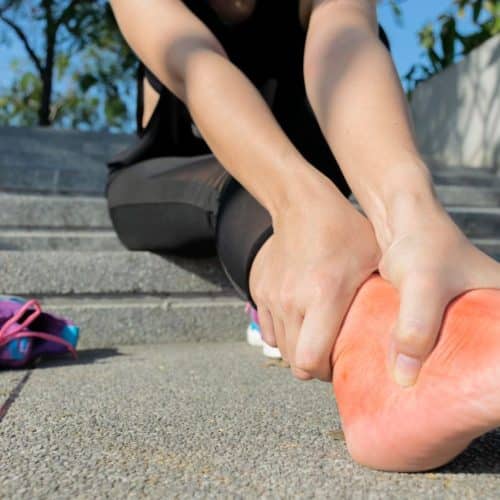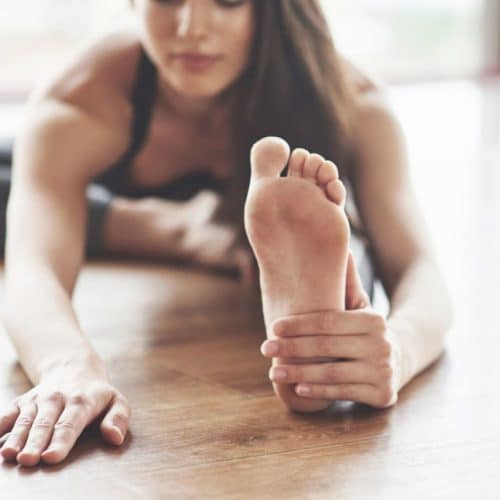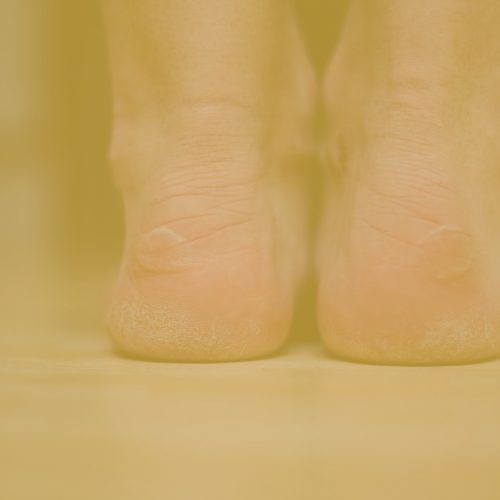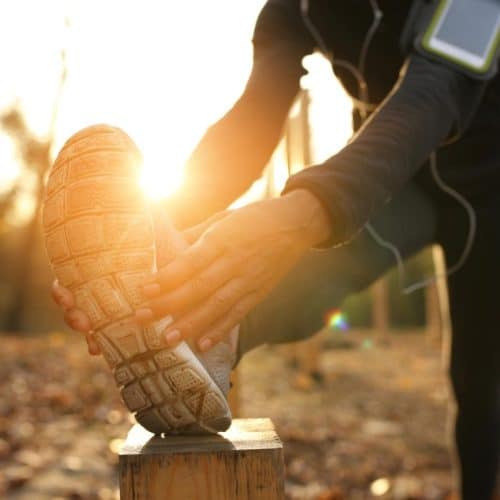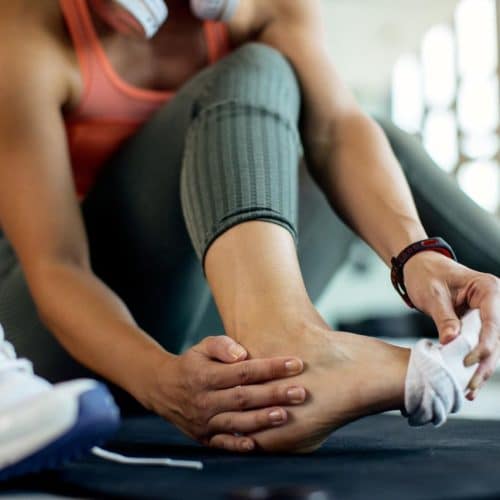Do you find yourself wincing with every step due to persistent knee pain? You’re not alone. Knee discomfort can be incredibly frustrating, affecting your daily activities and overall quality of life. Whether you’re an athlete, an office worker, or someone who enjoys staying active, understanding the underlying causes of knee pain is crucial for effective management. In this article, we delve into the common culprits behind knee discomfort, exploring the factors contributing to your aching knees.
Understanding the Knee Anatomy
Before we delve into the common causes of knee pain, it’s important to have a comprehensive understanding of the intricate anatomy that makes up the knee joint. The knee is a remarkable joint that connects the thigh bone (femur) to the shin bone (tibia) and facilitates a wide range of movements while providing stability to the lower body.
The knee joint is composed of several key components:
1. Bones
The femur, tibia, and patella (kneecap) are the primary bones that form the knee joint. The ends of these bones are covered in a smooth layer of cartilage that acts as a cushion and allows the bones to glide smoothly against each other during movement.
2. Ligaments
Bones are held together by strong bands of connective tissue called ligaments, which also serve to stabilise the joint. There are four primary ligaments in the knee, and they are as follows:
- Anterior Cruciate Ligament (ACL): This ligament prevents the femur from sliding backward on the tibia and provides rotational stability.
- Posterior Cruciate Ligament (PCL): Similar to the ACL, the PCL prevents the femur from sliding forward on the tibia.
- Medial Collateral Ligament (MCL): The MCL stabilises the inner side of the knee, preventing it from bending inward.
- Lateral Collateral Ligament (LCL): The LCL provides stability on the outer side of the knee, preventing it from bending outward.
3. Meniscus
The menisci are C-shaped wedges of cartilage located between the femur and tibia. These act as shock absorbers, distributing the load placed on the knee joint and providing cushioning during movement.
4. Tendons
Tendons are fibrous bands of tissue that link muscles to bones. They play a critical role in conveying the force that is generated by muscles to the bones, which is what makes movement possible. The patellar tendon is the tissue that joins the kneecap, or patella, to the tibia. This connection allows for the leg to be extended.
5. Synovium and Synovial Fluid
The synovium is a thin lining within the knee joint that produces synovial fluid, a lubricating substance that reduces bone friction and helps nourish the cartilage.
6. Articular Cartilage
Articular cartilage covers the ends of the bones where they meet in the joint. This smooth and slippery tissue allows pain-free movement by reducing bone friction.
Understanding the intricate interplay between these components is crucial in comprehending the potential sources of knee pain. When any of these structures are compromised due to injury, wear and tear, or other factors, it can lead to discomfort and pain.
Moreover, factors such as age, genetics, and lifestyle can play a significant role in the health of these structures, influencing the likelihood of experiencing knee pain.
Common Causes of Knee Pain
Knee pain is a widespread concern that can stem from various factors. Understanding these common causes is crucial for addressing discomfort, seeking appropriate treatment, and making informed decisions about knee health. Let’s delve deeper into the various reasons why knees may experience pain:
1. Osteoarthritis
Osteoarthritis, often called “wear and tear” arthritis, is a prevalent cause of knee pain, particularly among older Australians. This condition occurs when the protective cartilage that cushions the ends of bones in the knee joint begins to deteriorate over time. As the cartilage wears down, bones can rub against each other, causing joint pain, swelling, and stiffness. Factors such as age, genetics, previous injuries, and joint misalignment can contribute to the development of osteoarthritis.
2. Injuries
Knee injuries are a common source of acute pain and can occur due to accidents, sports-related incidents, falls, or sudden impacts. Ligament tears, such as anterior cruciate ligament (ACL) tears, meniscus tears, and fractures of the bones that make up the knee joint, can cause immediate pain, swelling, and instability. The injury’s severity determines the pain’s extent and the required treatment.
3. Overuse and Strain
Engaging in activities that place repetitive strain on the knee joint, such as bending, kneeling, or lifting heavy objects, can lead to overuse injuries. These injuries are characterised by inflammation in the tendons and surrounding tissues, resulting in pain and discomfort. People with frequent bending or heavy-lifting occupations are susceptible to overuse-related knee pain.
4. Patellofemoral Pain Syndrome
Known as “runner’s knee,” patellofemoral pain syndrome is characterised by pain around or behind the kneecap. This discomfort is often exacerbated by knee bending, such as running, squatting, or climbing stairs. Imbalances in muscle strength, kneecap misalignment, and overuse can contribute to this syndrome.
5. Bursitis
Bursae are small fluid-filled sacs located near joints, including the knee. Bursitis occurs when these sacs become inflamed due to excessive kneeling, repetitive motions, direct trauma, or underlying medical conditions. Inflammation of the bursae leads to localised pain, tenderness, and swelling around the affected area.
6. Tendinitis
Tendinitis involves inflammation of the tendons, which connect muscles to bones. In the knee, the patellar tendon can be affected by tendinitis. This condition is often seen in individuals who engage in frequent jumping or kicking activities, such as athletes and dancers. Tendinitis leads to pain, swelling, and discomfort around the front of the knee.
7. Rheumatoid Arthritis
Rheumatoid arthritis is an autoimmune disorder that can also affect the knee joint. In this condition, the body’s immune system attacks the synovium, causing inflammation, pain, and damage to the joint’s structures. Rheumatoid arthritis often affects multiple joints, leading to long-term joint damage if left untreated.
Understanding these common causes of knee pain is the first step toward effective management and prevention. By identifying the underlying factors contributing to knee discomfort, individuals can make informed decisions about lifestyle changes, seek appropriate medical care, and implement strategies to promote knee health and overall well-being.
Prevention and Management
Preventing and managing knee pain requires a proactive approach combining lifestyle adjustments, self-care, and professional guidance. By incorporating these strategies into your daily routine, you can promote knee health, reduce the risk of discomfort, and enhance your overall quality of life.
1. Maintain a Healthy Weight
Maintaining a healthy weight is crucial for knee health, as excess weight places additional stress on the joint. Every extra pound strains the knees, potentially accelerating wear and tear. By adopting a balanced diet rich in nutrient-dense foods and engaging in regular physical activity, you can achieve and maintain a healthy weight that alleviates the burden on your knees.
2. Regular Exercise
Engaging in regular exercise is essential for keeping the muscles around the knee joint strong and flexible. Low-impact activities such as swimming, cycling, and brisk walking are excellent choices, as they help improve joint stability without putting excessive strain on the knees. Strengthening the muscles that support the knee can reduce the risk of injuries and pain.
3. Proper Technique
Whether engaging in exercise or performing daily tasks, proper technique is vital for preventing knee strain. When lifting heavy objects, bend your knees and use your leg muscles instead of putting all the pressure on your back. During exercises, focus on maintaining proper form to avoid unnecessary stress on the joints. If you need more clarification about the correct technique, consider seeking guidance from a fitness professional or a physiotherapist.
4. Protective Gear
Wearing appropriate protective gear can help prevent knee injuries if you’re participating in sports or activities involving sudden movements or impacts. For example, knee pads while participating in sports like basketball or volleyball can provide extra cushioning and protection.
5. Proper Footwear
Wearing supportive and well-fitting footwear is essential for maintaining proper alignment and minimising strain on the knees. Shoes with adequate cushioning and arch support can help distribute your body weight evenly, reducing the pressure on the knee joint.
6. Listen to Your Body
Paying attention to your body’s signals is essential for preventing overuse injuries. If you experience discomfort or pain during activities, it’s important to listen to your body and give it the necessary rest. Pushing through pain can exacerbate the problem and lead to further complications.
7. Seeking Professional Help
If knee pain persists or worsens despite your efforts, seeking professional help is crucial. A healthcare practitioner, physiotherapist or sports podiatrist can diagnose the underlying cause of the pain and recommend appropriate treatment options. This may include physical therapy, medication, or, in some cases, surgical intervention.
8. Stretching and Flexibility
Incorporating regular stretching exercises into your routine can help improve the flexibility of the muscles and tendons around the knee joint. Stretching can enhance joint mobility and reduce the risk of stiffness and discomfort.
By implementing these preventive measures and management strategies, you can take an active role in promoting your knee health. Remember that every individual’s situation is unique, so it’s essential to tailor these recommendations to your specific needs and consult a healthcare practitioner if you have concerns about knee pain or discomfort. Prioritising knee health today can lead to improved mobility and well-being in the long run.
Seeking Professional Help
Seeking expert assistance is essential in order to identify the underlying reasons for knee pain and to receive suitable therapy for the condition. Consultation with a qualified healthcare practitioner can give beneficial insights, an accurate diagnosis, and a specialised treatment plan to manage your knee discomfort properly. The following are some reasons why you might want to consider getting help from a professional:
1. Expert Diagnosis
Consultation with a healthcare practitioner is very necessary in order to acquire an appropriate diagnosis if you are suffering from knee pain that is either severe or chronic. A physician or orthopaedic expert will conduct a comprehensive physical examination, examine your medical history, and request diagnostic tests such as X-rays or MRIs to evaluate the status of your knee joint and detect any structural abnormalities or injuries. This is done in order to determine whether or not you have any knee injuries.
2. Customised Treatment
Knee pain is experienced differently by each person, and the treatment strategy that is most effective will be determined by the kind and degree of the particular patient’s discomfort. A qualified healthcare practitioner can develop an individualised treatment plan for the patient, which may include the use of anti-inflammatory and painkilling medications, physical therapy to enhance range of motion and muscular strength, and, if necessary, surgical intervention.
3. Preventing Further Complications
Ignoring knee discomfort or attempting to self-diagnose and manage it might lead to further difficulties if either of these things are done. Some disorders have the potential to deteriorate over time and lead to chronic discomfort or irreparable joint damage if they are not addressed. Seeking expert assistance at an earlier stage can reduce the likelihood of adverse long-term effects and enhance one’s chances of making a full recovery.
4. Professional Advice
Modifications to one’s way of life, certain exercises, and specific approaches can all be recommended by a trained healthcare practitioner as effective means to treat and avoid knee discomfort. They will be able to direct you towards the most effective exercises to bolster the muscles surrounding the knee, propose adjustments to your regular activities that will help minimise strain, and offer ergonomic recommendations to optimise your knee health.
5. Monitoring Progress
If you are receiving therapy for knee pain, a qualified healthcare practitioner can evaluate your progress and make any required modifications to your treatment plan, depending on how you respond to the medication or other interventions. This continual monitoring will verify that your therapy continues to be successful and will allow for any necessary adjustments to be made.
6. Addressing Underlying Issues
Knee discomfort can be an indication of a more serious underlying medical disease, such as rheumatoid arthritis or gout, in certain instances. These possible problems can be identified by an expert in the healthcare field, who can also suggest suitable management solutions to address the underlying cause of the pain.
7. Considering Long-Term Implications
It is crucial for people who suffer from chronic knee diseases, such as osteoarthritis, to seek the assistance of a specialist in order to manage the condition and reduce the impact it has on their day-to-day lives. A healthcare practitioner can give advice on managing long-term pain, making adaptations to one’s lifestyle, and considering alternative procedures in order to preserve joint function and quality of life.
It is essential to look for expert assistance while dealing with knee pain to manage and alleviate the discomfort you are feeling successfully. An experienced healthcare practitioner can give you a precise diagnosis, individualised treatment strategies, and helpful direction to guarantee the most favourable outcome for your knee health.
Do not be afraid to get in touch with a healthcare practitioner if you are uncertain about the cause of your knee discomfort or concerned about the impact it is having on your day-to-day activities. This person will be able to give you the required assistance and knowledge.
Conclusion
In conclusion, gaining an awareness of the factors that contribute to knee discomfort is essential for leading a lifestyle that is both healthy and active. As we have investigated the numerous reasons that might lead to knee pain in Australia, it has become clear that this problem can have a variety of origins. The intricacies of knee discomfort, which can be caused by various factors, including accidents, overuse, and medical disorders, demand careful evaluation and appropriate therapy.
If you find yourself wondering, “Why are my knees hurting?” it is imperative that you keep in mind that obtaining the opinion of a qualified healthcare practitioner is the first step towards getting relief from your symptoms. Ignoring prolonged knee discomfort might result in further issues and make it difficult for you to go about your daily activities. When dealing with knee pain, taking preventative measures will help ease discomfort and protect against the occurrence of any complications in the future.
Are you finding that knee discomfort has been giving you a lot of trouble lately? Remember that determining the underlying reason for your knee discomfort is necessary for proper therapy of the condition. In the comment box below, you are welcome to express any questions, concerns, or experiences.
Our seasoned professionals are available to discuss their observations with you and make suggestions specific to your circumstances. Do not let discomfort in your knees prevent you from moving on; instead, take the first step today towards healthy knees.
Content Summary
- Knee discomfort can be incredibly frustrating, affecting your daily activities and overall quality of life.
- Whether you’re an athlete, an office worker, or someone who enjoys staying active, understanding the underlying causes of knee pain is crucial for effective management.
- Knee pain can stem from various sources, from overuse injuries to degenerative conditions.
- Muscle imbalances, improper form during physical activities, and even lifestyle factors such as excess weight can all play a role.
- Before we delve into the common causes of knee pain, it’s important to have a comprehensive understanding of the intricate anatomy that makes up the knee joint.
- Understanding the intricate interplay between these components is crucial in comprehending the potential sources of knee pain.
- When any of these structures are compromised due to injury, wear and tear, or other factors, it can lead to discomfort and pain.
- Moreover, factors such as age, genetics, and lifestyle can play a significant role in the health of these structures, influencing the likelihood of experiencing knee pain.
- Knee pain is a widespread concern that can stem from various factors.
- Knee injuries are a common source of acute pain and can occur due to accidents, sports-related incidents, falls, or sudden impacts.
- Ligament tears, such as anterior cruciate ligament (ACL) tears, meniscus tears, and fractures of the bones that make up the knee joint, can cause immediate pain, swelling, and instability.
- The injury’s severity determines the pain’s extent and the required treatment.
- Engaging in activities that place repetitive strain on the knee joint, such as bending, kneeling, or lifting heavy objects, can lead to overuse injuries.
- These injuries are characterised by inflammation in the tendons and surrounding tissues, resulting in pain and discomfort.
- People with frequent bending or heavy-lifting occupations are susceptible to overuse-related knee pain.
- Known as “runner’s knee,” patellofemoral pain syndrome is characterised by pain around or behind the kneecap.
- In the knee, the patellar tendon can be affected by tendinitis.
- Tendinitis leads to pain, swelling, and discomfort around the front of the knee.
- Rheumatoid arthritis is an autoimmune disorder that can also affect the knee joint.
- Maintaining a healthy weight is crucial for knee health, as excess weight places additional stress on the joint.
- By adopting a balanced diet rich in nutrient-dense foods and engaging in regular physical activity, you can achieve and maintain a healthy weight that alleviates the burden on your knees.
- Engaging in regular exercise is essential for keeping the muscles around the knee joint strong and flexible.
- Whether engaging in exercise or performing daily tasks, proper technique is vital for preventing knee strain.
- Wearing appropriate protective gear can help prevent knee injuries if you’re participating in sports or activities involving sudden movements or impacts.
- Wearing supportive and well-fitting footwear is essential for maintaining proper alignment and minimising strain on the knees.
- Paying attention to your body’s signals is essential for preventing overuse injuries.
- Incorporating regular stretching exercises into your routine can help improve the flexibility of the muscles and tendons around the knee joint.
- By implementing these preventive measures and management strategies, you can take an active role in promoting your knee health.
- Remember that every individual’s situation is unique, so it’s essential to tailor these recommendations to your specific needs and consult a healthcare practitioner if you have concerns about knee pain or discomfort.
- Seeking expert assistance is essential in order to identify the underlying reasons for knee pain and to receive suitable therapy for the condition.
- Consultation with a qualified healthcare practitioner can give beneficial insights, an accurate diagnosis, and a specialised treatment plan to manage your knee discomfort properly.
- Consultation with a healthcare practitioner is very necessary in order to acquire an appropriate diagnosis if you are suffering from knee pain that is either severe or chronic.
- Modifications to one’s way of life, certain exercises, and specific approaches can all be recommended by a trained healthcare practitioner as effective means to treat and avoid knee discomfort.
- If you are receiving therapy for knee pain, a qualified healthcare practitioner can evaluate your progress and make any required modifications to your treatment plan, depending on how you respond to the medication or other interventions.
- Knee discomfort can be an indication of a more serious underlying medical disease, such as rheumatoid arthritis or gout, in certain instances.
- These possible problems can be identified by an expert in the healthcare field, who can also suggest suitable management solutions to address the underlying cause of the pain.
- It is crucial for people who suffer from chronic knee diseases, such as osteoarthritis, to seek the assistance of a specialist in order to manage the condition and reduce the impact it has on their day-to-day lives.
- A healthcare practitioner can give advice on managing long-term pain, making adaptations to one’s lifestyle, and considering alternative procedures in order to preserve joint function and quality of life.
- It is essential to look for expert assistance while dealing with knee pain to manage and alleviate the discomfort you are feeling successfully.
- Do not be afraid to get in touch with a healthcare practitioner if you are uncertain about the cause of your knee discomfort or concerned about the impact it is having on your day-to-day activities.
- In conclusion, gaining an awareness of the factors that contribute to knee discomfort is essential for leading a lifestyle that is both healthy and active.
- As we have investigated the numerous reasons that might lead to knee pain in Australia, it has become clear that this problem can have a variety of origins.
- The intricacies of knee discomfort, which can be caused by various factors, including accidents, overuse, and medical disorders, demand careful evaluation and appropriate therapy.
- Ignoring prolonged knee discomfort might result in further issues and make it difficult for you to go about your daily activities.
- When dealing with knee pain, taking preventative measures will help ease discomfort and protect against the occurrence of any complications in the future.
- Remember that determining the underlying reason for your knee discomfort is necessary for proper therapy of the condition.
- Do not let discomfort in your knees prevent you from moving on; instead, take the first step today towards healthy knees.
FAQs
1. Can knee pain be a sign of a serious medical condition?
While minor pain might be due to overuse, persistent or severe pain could indicate a more serious underlying issue. Consulting a healthcare practitioner is advisable.
2. Can knee injuries heal on their own?
Some minor injuries might improve with rest and self-care, but significant injuries often require medical intervention for proper healing.
3. Is surgery the only option for knee pain management?
Surgery is usually considered after non-surgical treatments have been exhausted. Your healthcare practitioner will recommend the best action based on your condition.
4. Can I still exercise with knee pain?
Certain exercises may be recommended depending on the cause and severity of your knee pain, while others should be avoided. Consult a healthcare practitioner before continuing or starting any exercise regimen.
5. Are there any natural remedies for knee pain?
Hot and cold therapy, as well as certain supplements like glucosamine, might provide relief for some individuals. However, it’s essential to consult a healthcare practitioner before trying any remedies.



